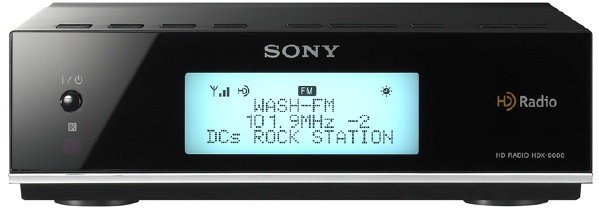Sony XDR-F1HD
- 15 May 2008 11:44
- 1555

This is a $100 (that’s no typo) tuner that blows away the classic “super tuners” of McIntosh, Marantz, Sequerra, Accuphase, etc., according to FM experts who know more than I do.
Sony Corporation (made in China). Voice: 1 (800) 222-SONY. Web: www.sony.com/service. XDR-F1HD FM/AM Digital Tuner, $99.95 (available from a large number of Internet retailers). Tested sample owned by The Audio Critic.
Analog FM radio can be of fairly high quality if the signal is fat enough, the antenna good enough, and there’s no multipath. Big ifs. Digital HD radio (not to be confused with satellite radio) is much more consistent and reliable. The digital signal is bundled with the analog signal and transmitted over the same broadcast frequency. Usually there are three programs broadcast by one station over a given frequency: the analog FM program, the HD1 program duplicating the analog program, and the HD2 program, which is generally without commercials. The available bandwidth permits a data rate of 48 Kbps for HD1 and 48 Kbps for HD2, or 96 Kbps if there is only one HD channel. Such rates are labeled CD-quality, or near-CD-quality, by iBiquity Digital, the developer and licenser of HD radio, a somewhat wishful appellation in my opinion. (More about that below.)
HD radio broadcasts appear to be proliferating at a higher rate than HD radios and tuners, at least from where I’m sitting. This $100 Sony is a fantastic bargain and appears to be just what the doctor ordered. Unfortunately I don’t have the RF test equipment for generating and measuring FM frequencies, but Brian Beezley does (go to http://ham-radio.com/k6sti/xdr-f1hd.htm). He and his associate Bob Smith, both of whom know what they’re talking about, report that the XDR-F1HD outperforms on the test bench every known tuner under the sun, regardless of price. The secret is a new NXP (formerly Philips) chipset that implements the front end for digital IF reception as well as the digital-IF DSP back end. This proves once again that innovative engineering at reduced cost is able to supersede obsolete high-end solutions (how I love to reiterate that!).
In my location (Bucks County, Pennsylvania, about halfway between Philadelphia and Allentown) I am now able to receive many more programs than ever before without noise, breakup or interference. As for audio quality, here’s what I have observed so far: HD radio at 48 Kbps is wider in both frequency range and dynamic range than analog FM. The noise floor is also incomparably better—basically total silence. What is missing at the reduced data rate is the spatial detail. The subtle spatial clues that render a clear 3-D soundstage and provide air around the instruments are better on the best analog FM broadcasts if cleanly received and reproduced through a really good pair of loudspeakers. I haven’t been able to determine if this is true when the HD radio transmission is at 96 Kbps because all high-quality stations in my area carry both HD1 and HD2 programs. Another problem is that if the HD1 channel locks in, then the analog FM channel is not available, and if it doesn’t lock in, the analog FM signal is most likely equally flawed. One of these days the government will eliminate all analog FM broadcasts, as it has analog TV (beginning February 2009), and then the bandwidth will be available for much higher digital data rates, resolving the quality problem once and for all.
I must add that all of the above observations are based on reception with the excellent Terk FM Pro FM-50 indoor/outdoor antenna with “Power Injector.” (See the old print Issue No. 25 of The Audio Critic, downloadable from this website.) The antenna is permanently fixed in position, aimed at Philadelphia.
The XDR-F1HD also receives AM, both analog and HD, but with the rudimentary AM antenna that comes with the tuner I haven’t received any music broadcasts worth discussing. Talk programs are fine at the reduced data rates.
In appearance, the Sony is small, cute, and cuddly, sporting a 2½-inch display window where you can see the station and channel ID, and sometimes even the title and performer of the selection being played. All the controls are on top of the unit and are duplicated on the “remote commander” (their nomenclature, not mine). Bottom line: highly recommended.
